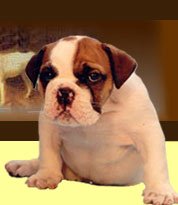Entering Shows
Before entering any shows your bulldog must be well socialised and used to being handled by strangers.
In the UK and the US puppies are accepted in the show ring from the age of six months on, but as all puppies mature at different ages refrain from entering any breed shows until you are sure that both your puppy and you are ready. Sometimes, it is often wiser to hold back young dogs that are not yet ready for the show ring, than risk his chances of being placed.
The first time you attend, just sit and watch the other, more experienced handlers. In the meantime your puppy can become accustomed to the older dogs and new surroundings before making his debut.
Unlike most other breeds, which stand sideways, bulldogs are always exhibited front-on, facing the judge.
.
.
.




